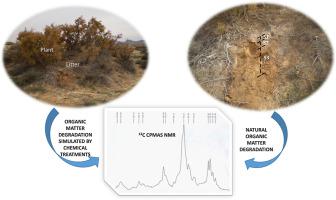Journal of Arid Environments ( IF 2.6 ) Pub Date : 2021-10-05 , DOI: 10.1016/j.jaridenv.2021.104639 Fulvia Tambone 1 , Luca Trombino 2 , Anna Masseroli 2 , Massimo Zilio 1 , Tommy Pepè Sciarria 1 , Daniele Daffonchio 3 , Sara Borin 4 , Ramona Marasco 3 , Ameur Cherif 5 , Fabrizio Adani 1

|
A soil, classified as Arenosol (Eutri-Aridic Arenosol (Calcaric)), located in Neffatia (Tunisia) and populated by the shrub tamarisk (Tamarix aphylla), was studied to assess how the litter deriving from tamarisk can affect its characteristics. Several parameters were considered: particle size distributions (PSD), pH, cation exchange capacity (CEC), total CaCO3 content, total nitrogen (TKN), phosphorus and total organic carbon (TOC). Down the soil profile the pH increased from 7.83 to 8.32 as a probable consequence of salts accumulation deriving from the mineralization of the organic matter and the limited leaching due to low rainfall. As expected, TOC and TKN decreased, from the top downwards, and the two parameters were well correlated (TOC vs TKN: R2 = 0.98; p < 0.05; n = 3). CEC assumed progressively lower values reflecting the decreasing organic matter content (CEC vs TOC: R2 = 0.93; p < 0.05; n = 3). PSD showed that the presence of roots influenced the quantity of fine particles down the profile and the PSD cumulative curves were indicative of an aeolian origin for the soil parent material, confirming the hypothesis that tamarisk interacts with the environment, trapping sediment and forming the so-called phytogenic dunes. By chemical and spectroscopic analyses, it was possible to assess that tamarisk plant residues directly contributed to the soil organic matter (SOM) accumulation and characteristics. Stable SOM (ligno-humic fraction) closely resembles that of the plant (leaves and stems) and is chemically lacking in the more easily degradable organic components such as fats, hemicellulose, cellulose and proteins. 13C CPMAS NMR spectroscopy showed that the so-called soil ligno-humic fraction consists of aromatic molecules such as tannins, and aliphatic carbon (i.e. cutins and suberins) already present in the plant and preserved by mineralization processes because they are the most resistant to biological degradation.
中文翻译:

柽柳对突尼斯自然半荒漠区土壤有机质演化的贡献
对位于 Neffatia(突尼斯)并种植有灌木柽柳(Tamarix aphylla)的被归类为 Arenosol(Eutri-Aridic Arenosol(Calcaric))的土壤进行了研究,以评估源自柽柳的凋落物如何影响其特性。考虑了几个参数:粒度分布 (PSD)、pH、阳离子交换容量 (CEC)、总 CaCO 3含量、总氮 (TKN)、磷和总有机碳 (TOC)。在土壤剖面下方,pH 值从 7.83 增加到 8.32,这可能是由于有机质矿化和低降雨导致的有限浸出导致盐分积累的可能结果。正如预期的那样,TOC 和 TKN 下降,从上到下,两个参数相关性很好(TOC vs TKN:R2 = 0.98;p < 0.05;n = 3)。CEC 假设逐渐降低的值反映了有机物含量的下降(CEC与TOC:R 2 = 0.93; p < 0.05;n = 3)。PSD 表明,根的存在影响了剖面上细颗粒的数量,PSD 累积曲线表明土壤母质的风成起源,证实了柽柳与环境相互作用、捕获沉积物并形成如此的假设。称为植物性沙丘。通过化学和光谱分析,可以评估柽柳植物残留物对土壤有机质 (SOM) 积累和特性的直接贡献。稳定的 SOM(木质腐殖质部分)与植物(叶和茎)非常相似,并且在化学上缺乏更容易降解的有机成分,如脂肪、半纤维素、纤维素和蛋白质。13C CPMAS NMR 光谱显示,所谓的土壤木质腐殖质部分由芳香分子如单宁和脂肪碳(即角质和木栓质)组成,这些分子已经存在于植物中并通过矿化过程保存下来,因为它们对生物的抵抗力最强。降解。











































 京公网安备 11010802027423号
京公网安备 11010802027423号